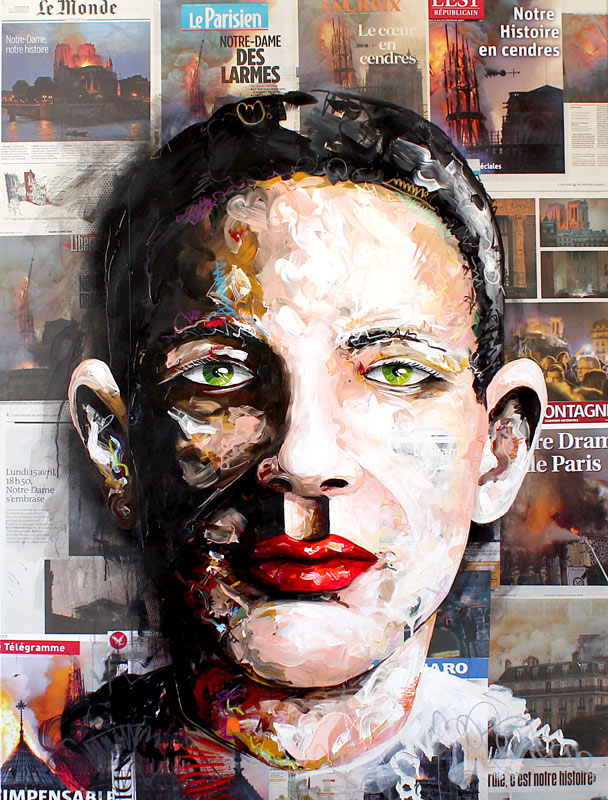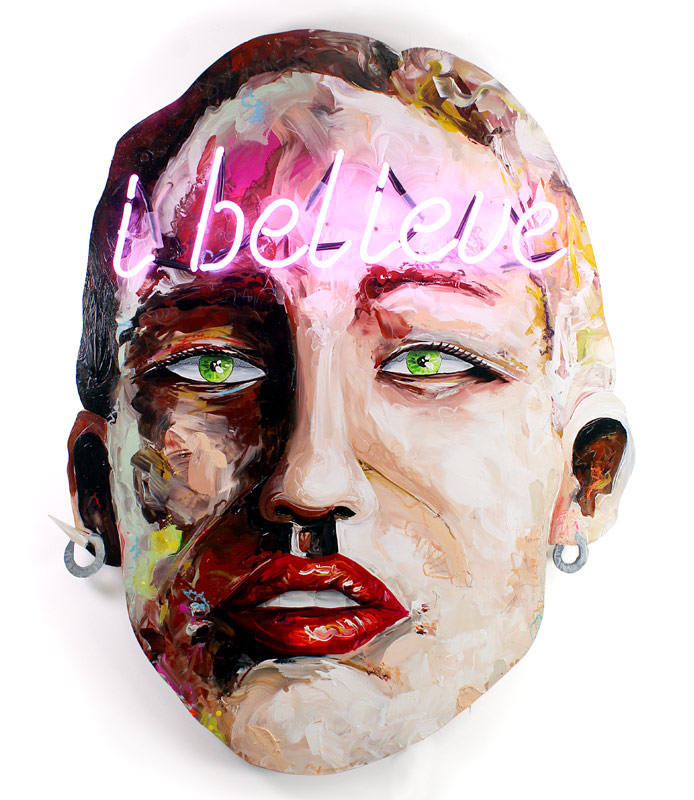solo exhibitions
2014 – „Blick“ München
2015 – Köln
2016 – „l’artista non è presente“ / Florenz
2017 – „Newspaper“ / München
2018 – „believe“ / München
2018 – „X-Rays“ / Köln
2020 – „I am Peintre X” / München
2022 – “Femme X” / Ulm
selected art fairs
2013 – Bloom Köln
2014 – Amsterdam Light Festival
2015 – Art Central Hong Kong
2015 – Scope Basel
2016 – Art Fair Köln
2017 – Art Karlsruhe
2018 – Art Karlsruhe
2019 – AAF Brüssel
2019 – AAF Hamburg
2022 – Art Karlsruhe
selected group exhibitions
2014 – “Virtue of Fools” eine Hommage an Francis Bacon / München
2015 – „Urban Beauty“ / Stuttgart
2016 – „SIXPACK“ / Köln
2019 – „Superhero“ / Stuttgart
2020 – “Kopfsachen” Stuttgart
2020 – “X Change” / München
When the Artist is Not There – Peintre X in an Exclusive Interview
ART.FAIR Cologne 2016, Graffiti & Street Art • Ana Bambic Kostov
In the prominent corner of the last year’s ART.FAIR Cologne, there was a striking image. A Batman portrait with a neon addition, accompanied with similar pieces, in what was often mentioned as one of the best curated booths at the event. The space belonged to the 30works gallery and the work was signed as a piece by Peintre X, a mysterious figure in contemporary urban art movement.
A little too approachable at a first glance, the works of Peintre X in fact abound with layers, both painterly and philosophical, all of which originate from the street. The exaggerated close-ups are his signature, while the faces he portrays are a figment of the artist’s imagination, born where contemplation and found imagery combine. An intriguing story follows this devotee to contemporary portraiture and we’ve had the chance to learn some of it at the occasion of the final chapter of ART.FAIR in Cologne.
Widewalls: You are dedicated to portraiture. Are your subjects real people?
Peintre X: The most of them are not. They are rather faces in my mind that I have collected from different places – with eyes and mouth and the size of the face and the heads – upon which I build a face. Sometimes I have some real models, but I use the photographic parts mostly for inspiration. The final result is an image I changed into something else.
WW: All of your portraits are visually strong. Big eyes, bold strokes, all are very powerful and aggressive. What technique do you prefer to achieve such a result?
PX: I agree, I do like pieces with strong energy. So, everything I do is done with a brush. This way, I feel this energy is best transferred to people. Also, I use a lot of newspapers as the source – they are the best mirror of the world, right? So, in them I find what is interesting to me and collect specific papers from a specific town or area, to add actual events into my artworks. My portraits are painted on these newspaper layers. It’s as if they are fighting the tragic everyday stories, representing people who become stronger after being knocked down. Additionally, I try to use as many artist’s stories as backgrounds, like I did in “Life is Not Always a Damien Hirst”, like you see.
Inspirations and Influences
WW: I’ve noticed the Damien Hirst series before and wanted to ask you more about it.
PX: Sure! The first idea I got came from the diamond skull of Damien Hirst. Playing around with the central theme of that piece, I wanted to say that life is not always decorated with diamonds. So, I focused on the background story of the artist, the invisible one, behind the diamond surface. There is another series I worked on, called The artist is not present. The essence of Ms. Abramovic, Serbian artist from New York, is in the very presence of the art that she represents herself. I have turned this idea on me, because my art is present without me. I’m not an existing person on it.
WW: Let’s go back to Damien Hirst, I would like to hear about your own view on Hirst and his art. Do you think he is a paradigm of contemporary art in conceptual, or maybe even in the market sense? Is this way of criticizing his work?
PX: Well, Damien Hirst is a special thing in the art world. I think he uses diamond things deliberately, which makes his work expensive in the market. For me it’s a kind of Pop Art. What I see is that he shows people this super-expensive piece and calls them to buy it, so in this way he’s kind of like Andy Warhol. He makes things in the art world and says – Ok, now you buy it, buy it, buy it. Personally, I appreciate this idea, but this is far from what I am trying to do. I always talk about that essence which is behind the diamonds, the truth behind the flashy surface. I do use some Pop Art elements, but it’s about the meaning and the artwork itself, it’s story, because I am not there, not present.
Lighting Up the Art
WW: You use a lot of neon in your work. What does it mean?
PX: I like it when there is little more than only painting. I like it when you can see the third dimension, besides the canvas. So my work might step out of traditional and contemporary painting, but I’m actually a real fan of Pop Art, because when these elements come together, this is what I like the most. The neon light is there, adding another element and it should always stay on.
WW: You mentioned that you are inspired by Pop Art, but I know that you have a background in street art or graffiti, so can I hear a little bit more about that?
PX: Just like the most of the young artists coming from the graffiti scene, when I was younger I started in the street and did it for a long time. I painted many trains when I was younger. That was at the beginning of my career as an artist. Later, I moved on to legal ways of creation, working on canvas, and expanding my techniques beyond aerosol and cans, going above this limit. This is how I switched to painting, about ten or twelve years ago. Still, I do go back to aerosol sometimes. Even outside.
WW: Can we see some remnants of your street work in the portraits you do today?
PX: I stopped with the street art a couple of years ago and worked with the brush. I must say that the idea for my street art is the impression I get from the people outside, from the world. My goal now is to bring the art closer to people who don’t go to galleries or in museums, to give them back the inspiration I took from all those faces outside of walls.
WW: Are you again active on the streets, then?
PX: Yes.
WW: Where?
PX: Everytime I travel, in Germany most of the time. Occasionally, I go out to England or Asia. The most of the street pieces are small, that’s easy for me to render some corner in the wall. And I also sometimes add a small addition next to a wall piece, something people can take with them, like information about the wall piece. I see they like the idea.
Social Engagement Via Street Art
Following the trail of street art, Peintre X continues to cherish his anonymity and reluctantly shows his face. His activities lie in a form of actual social engagement, through which he instigates donations to charity by giving away art.
WW: What if your artwork is taken down?
PX: That can happen. When I hang it up on the streets, the artwork belongs to the society, it’s not mine anymore. Whatever happens is ok.
WW: Do you ever think that your art could get really expensive in say, ten years from now and the people who took works from the street could sell it and get rich?
PX: Maybe, I don’t know. It doesn’t concern me, it concerns the society, the environment. I always mention on these little additions that if they take the piece, they should feel free to donate something to charity.
WW: That’s true social engagement.
PX: Yes. It’s very interesting when I get an email from people saying that they’ve donated to a certain cause, because they got my artwork. I believe that when I give an artwork and somebody takes it and then donates on this account, this is what can bring a change to the world.
Die Bildnisse des Peintre X
Mal direkt, mal indirekt oder gar versteckt hinter einer Maske: die vielseitigen Blicke der Bildnisse des Peintre X sind eines jedoch immer: eindrücklich und einprägsam. Es begegnen uns überwiegend überlebensgroße Köpfe mit einem nah gewählten Ausschnitt – die Betrachtung ist unmittelbar und wird zu einem hautnahen Erlebnis. Der expressive Pinselduktus steht dem gegenüber und verfremdet den eindrücklichen Ausdruck der Geschöpfe des Künstlers – statt detaillierter Lupenoptik oder gar Hautstruktur eröffnet sich pastoser Farbauftrag. Von Nahem lässt sich bei dem einen oder anderen Bildnis ein flächiger Hintergrund blicken mit fragmenthaften und selbst zusammengefügten Ausschnitten von Zeitungen und Comics, die eines gemeinsam haben: die absichtliche Zusammenführung durch den Künstler und die Schau eines Themengebietes. Ob Katastrophenbesprechungen oder Comicheftseiten, die Antlitze des Künstlers werden in einen spezifischen Sachverhalt gebettet. Um dann wiederum diesem enthoben zu werden, wenn Peintre X ein Portrait mit seinem Kopfumriss für sich stehen lässt. Das Gesicht bemächtigt sich somit seines aktuellen Umfelds und wird Teil davon, tritt in eine Wechselbeziehung und wird zum künstlerischen Objekt. Hier wie dort stehen die Bildnisse des Peintre X jedoch für das einzelne Subjekt. In der Nachrichtenflut unserer neuen Medien darf nicht vergessen werden, dass sich letztendlich alles um Individuen dreht. Die Form der klassischen Portraitmalerei spielt diesem Anliegen zu und wird von dem Künstler gekonnt in ein zeitgenössisches Gewand gepackt – sowohl aus stilistischer als auch thematischer Sicht. 

Synthese von expressiver Malerei und Pop Art
Mit „I believe“ hat sich nun ein weiterer Sinnspruch in die Bilderwelt von Peintre X gesellt. Neben den bisher bekannten Lettern „AINP“ (The artist is not present) oder „LIF EIS NOT A l WAYS ADAM I ENHI RST“ reiht sich nun eine Aussage mit äußerst positiver Konnotation in den Kontext. Es ist der Glaube an die vorwiegend immateriellen Dinge, der sie zu etwas Wertigem, etwas Wertvollem erhebt. Stolz und mit neuem Hochglanz-Finish erstrahlen die neuen Geschöpfe des Peintre X und verkünden ihre positive Einstellung. Damit tritt der Künstler in die Tradition der Pop Art und fusioniert diese mit Elementen der klassischen Portraitmalerei im Stile des Impressionismus, des Expressionismus und der Objektkunst. Der Künstler wählt bewusst eine Multimedialität, um seine künstlerische Intention zu entfalten und ihr gerecht zu werden.
Um eine rechtliche Absicherung zu haben, sind alle Date die jemals von Peintre X veröffentlich werden (online & offline) als Mockumentary anzusehen, incl aller Arbeiten die von Peintre X erstellt werden.
